I discovered an amazing pamphlet from my archives, “The Large Quantity Barbecue” by William Loeffel, Chairman of the University of Nebraska’s Department of Animal Husbandry. This pamphlet may date back to the 1930s, I think it belonged to my Grandfather, he was an old USDA meat inspector and worked around the Omaha stockyards and slaughterhouses. I’ve scanned the 27 page pamphlet and you can download it as a 5Mb PDF.
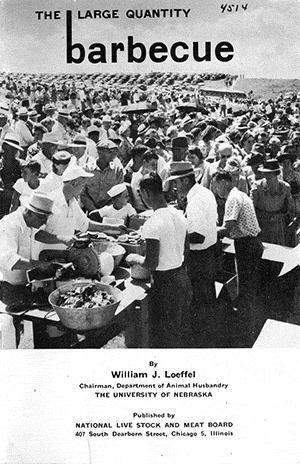
The scope of this brochure is breathtaking. This isn’t for someone who wants a steak on the barbecue. This isn’t even for a large party. This book is for someone who wants to turn a small herd of cattle into a feast for hundreds, perhaps thousands of people. Sides of beef are buried in huge fire pits dug in the raw earth. The cooked meat is pulled from the fire with a pitchfork. And everything is immaculately documented, from the logistics of mounting a huge barbecue to efficient methods of rapidly serving the mountains of beef. I salute Mr. Loeffel, the Barbecue Master.
Footnote: I did a little research and found a short biography of Mr. Loeffel (downloadable as a tiny 36k PDF at this link
). It indicates Mr. Loeffel attained the rank of Chairman in 1940, so this pamphlet dates back no earlier than that time. The biography says this was his most popular pamphlet and was nationally distributed. From his biography, it seems that he was quite a colorful character.
Category: General
My Childhood Toys
When my Mother died and I cleaned out her house, I found an astonishing box labeled “Charles’ Toys.” I had no idea any of my toys survived, I thought they’d been tossed out decades ago. I took a peek inside and immediately decided I could not deal with that little trip down Memory Lane, under the emotional circumstances. I packed it away until the time I felt I could look inside. And that time is today. So indulge me while I participate in one of the Internet’s silly little rituals, a photographic “Unboxing.”
Just the sight of the box itself sent me into paroxysms of nostalgia. This is a waterproof box from DeGroot Nurseries, my Dad’s greenhouse used to get 18-wheeler truckloads of green plants in these boxes. And I’d usually have to unload and unpack them, when I worked at the greenhouse on weekends. So in a way, this box is a symbol of Unboxing.

When I first opened the box, over three years ago, this newspaper was on the top of the stack. It’s the Des Moines Register from January 28, 1967, describing the Apollo 1 tragedy. When I saw the headline, I decided that the contents of this box might be too difficult to deal with, just after my Mother died. So I sealed it back up and didn’t open it again until today.
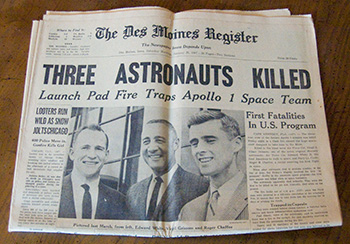
But fortunately, happier memories lay underneath. Oh boy, my old Spirograph! In fact, it’s the deluxe Super Spirograph set. I spent hours and hours fiddling with this this toy. The box is filthy, covered in dust, but who cares? It’s my old toy!
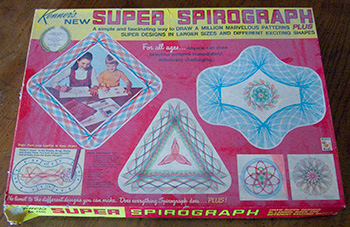
This is a handmade clay piggy bank, this was a souvenir from a vacation trip to Tijuana. I remember we had trouble getting through Customs with it, they wanted to break it open. If I shake it, I can hear a little change rattling around. I never wanted to put money in this bank because it has no opening, to get the change out I’d have to smash it to pieces.

Yes, I was a Boy Scout. The Fieldbook is particularly interesting, it has loads of practical information. I remember at Scout Camp we built a wood and rope bridge from instructions in the Fieldbook, using nothing but an axe.

This is my old Boy Scout mess kit, it folds up and everything is contained within the pan and lid, but here I’ve opened it up so you can see everything. I had to drag this along on camping trips and hikes, but I didn’t use it very often. It was hard to clean in the field, so I didn’t think it was very practical.

Wow, my bag of marbles! I still remember when I was in second grade and we’d play marbles at recess. We’d smooth off a spot in the dirt, draw a ring, and get our biggest, heaviest “shooters” to knock our opponents’ little marbles out of the ring. I remember the school eventually banned marble games, there were too many disputes by sore losers when we played for keepsies.
If you look close, on the right, there’s a tiny little blue high heeled shoe, it must belong to my sisters’ Barbie Dolls. I don’t know how it got in there.
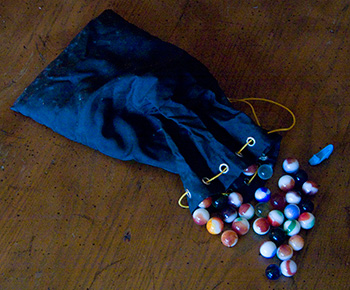
My handprint, cast in plaster. This must be a kindergarten project. My Mom must have kept this precious little memory stored away for years, I don’t recall making it or ever seeing it.
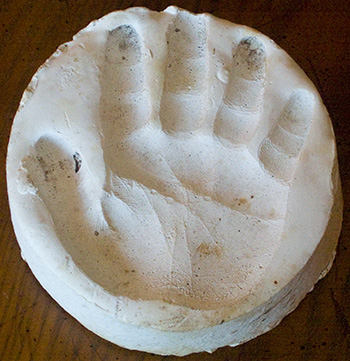
Here are a bunch of books. Obviously I was a space nut, I wanted to be an astronaut when I grew up. Check out the retro artwork!
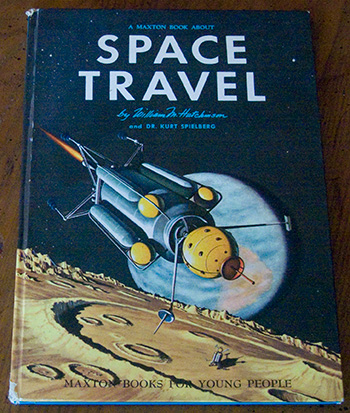
Another space book. Sorry, it’s a boring cover with no pretty artwork.
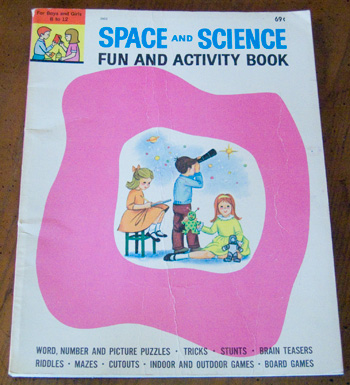
Manuals that came with my telescope.

Manual for an astrolabe! I don’t remember owning this, I sure would enjoy having this astrolabe today. But all I’ve got is the manual.
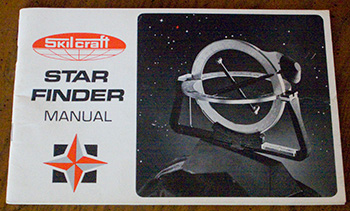
“How and Why” books, I love the retro artwork. Hmm.. that last book doesn’t seem to fit with the theme of the other books, let’s call it Anthropology so it is vaguely scientific.
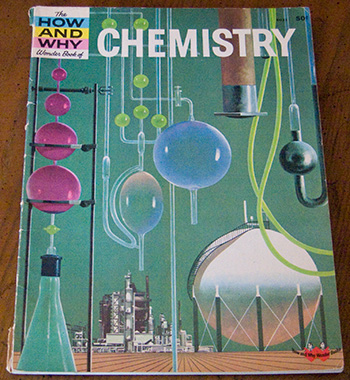

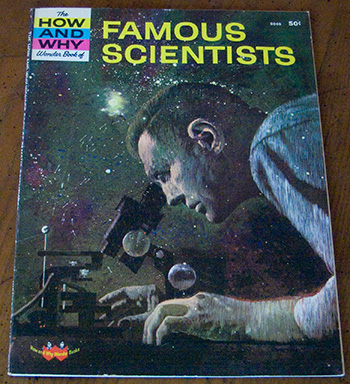

More space books. Yes, I was really into the space program. So was everybody, back in those days.
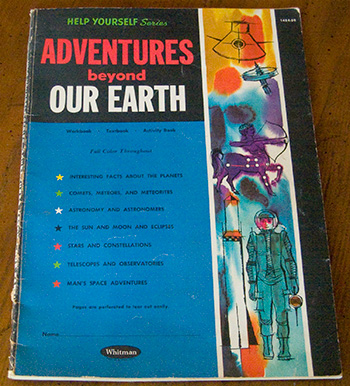
I remember receiving this book as a birthday present from a friend. I remember thinking, “what the hell?”
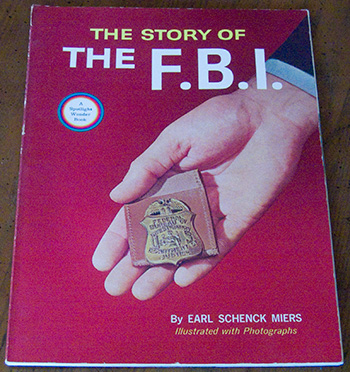
Back into space!
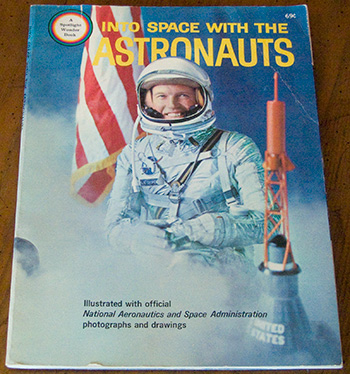
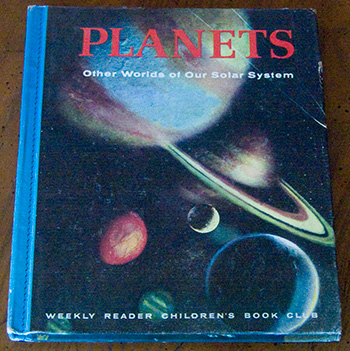
Souvenir catalogs from the Field Museum and the Museum of Science and Industry, in Chicago. I went back to visit the Museum of Science and Industry a few years ago, all the permanent displays I remember most fondly had been removed, replaced with badly designed interactive computer kiosks.

A souvenir brochure from Mexico, with an Olympics theme. Our whole family visited Mexico in 1968, but it was well before the Olympics so we never saw any of that hoopla.

A book of typeface samples. This isn’t actually my book, I recall buying this as a birthday present for my Grandfather. He had a little letterpress and drawers full of lead type, which I inherited when he died.

Mike Mars, Astronaut. I loved this book, it’s full of cheesy aerospace illustrations. The cover was so plain that I decided to photograph the frontispiece. This book had a big effect on me, I used to constantly make drawings of airplanes, pages and pages full.

A model of Explorer 18, a primitive satellite launched in 1963. The assembly instructions are crinkled and creased due to little smears of glue. The model is supposed to balance on a little post, but the little metal weights fell off. I guess they hadn’t yet invented SuperGlue back in 1963.
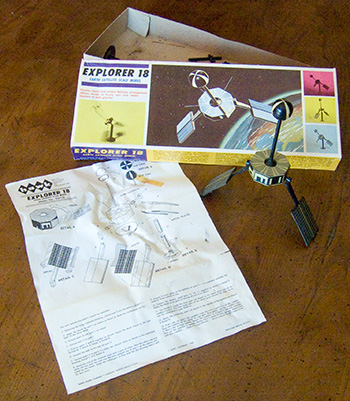
A box full of plastic figurines of army men, astronauts, and other small toys.
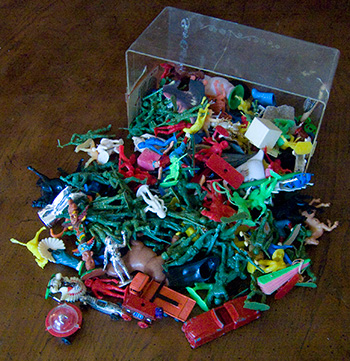
I had to laugh at one of the little plastic toys, so I decided to single it out for a solo photo. Sorry it isn’t any clearer, I don’t have a macro lens and this is only about an inch tall. You can almost see it’s a little silver man in a space suit inside a plastic bubble. I laughed because it reminded me of Davros in his Dalek Emperor sphere. But that episode of Doctor Who was probably made 20 years after this toy.
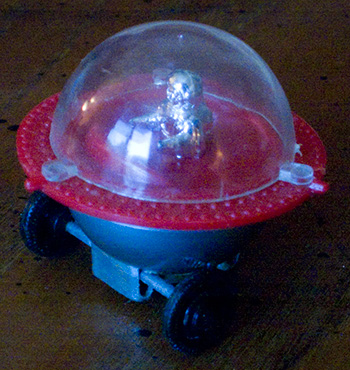
These are the control knobs for my Tasco 6 inch reflecting telescope. My beautiful telescope was stolen, but they didn’t get the control knobs! Oh well, I guess I’ll throw these in the trash, they’re totally useless.

Naked GI Joe and a muddy Evel Kinevel figurine. I used to have tons of GI Joe stuff, it’s all highly collectible now, especially stuff I had like Astronaut GI Joe. But my little brother found it and sold it all on eBay. I am still really irked about that.
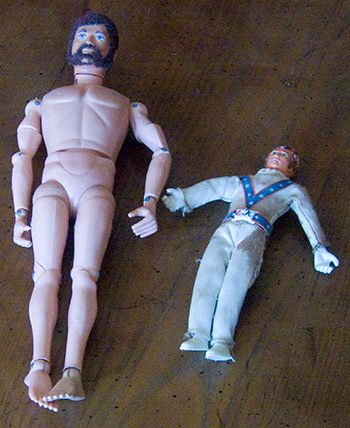
Here’s a little white cape with a Barbie label sewn inside. This obviously doesn’t belong to me. I thought it might fit the Evel Kinevel figurine, but it’s the wrong size.
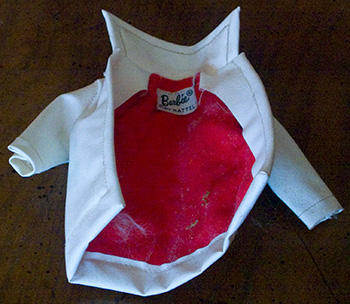
One segment of wooden track for a toy railroad. I remember I had a ton of this, I was always laying out tracks on the living room floor, and then when I had everything set up the way I wanted it, my parents would make me clean it up and put it all away. I wish I had the rest of this set, it would fill a huge box by itself.

I have saved the best for last: a Mattel Vac-U-Form. I must have burned myself on this toy hundreds of times, it was eventually recalled as a safety hazard. But what is really amazing, a box full of unused parts! The Vac-U-Form is highly collectible, but the original sheets of plastic are virtually unobtainable at any price. And I’ve got a whole bunch of them. Maybe I’ll fire it up for a little project.

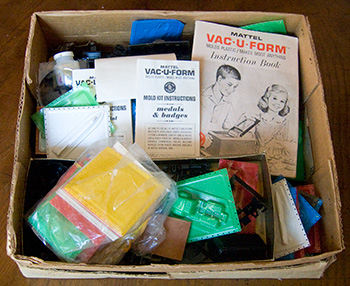
Well that is everything in the box. That was quite a trip down Memory Lane, everything in this box dates back to the 1960s. I can’t believe my Mom kept these toys carefully stored away for decades, it is her final gift to me. It brings a tear to my eye, not just seeing my favorite toys, but to think of my Mother keeping them for me to rediscover. That is a greater gift than any toy.
Out of Tune
When you first learn to play guitar, one of the first things that you must perfect is tuning your guitar. I remember when I first studied Classical Guitar, I used a tuning fork and harmonics to carefully tune each string. But that was before digital guitar tuners were invented. I’ve used digital guitar tuners for years, ever since the first one was released for Mac. I just plug my electric guitar into my Mac audio in port, and I can tune each string with digital precision. But for my little acoustic guitar, I still use my tuning fork.
When I bought my new Gibson Deluxe in 1976, it came with cheap tuning pegs and it would never stay in tune. I upgraded to some expensive Schaller tuning pegs, they’re much more accurate. Since I started using digital tuning, I noticed my bridge was out of adjustment a bit, so I took it to the shop to be optimized, it was a huge improvement. Now my guitar stays pretty much in tune forever.. or until I break a string. And the other day I broke a string.
I restrung my guitar and tuned up. Lately I use Guitar Rig, it has a tuner in its big bank of effects. I went back to playing along to some iTunes, doing my guitar effects in Guitar Rig. I’m playing along to tunes I’ve played a hundred times, my guitar is perfectly in tune, but suddenly my guitar is one note too low. What the hell?
I thought maybe it was some freak software glitch, some system update to the CPU timing made iTunes play back too fast, exactly one note too high? It took me a while to notice that I’d bumped a switch in Guitar Rig, I changed to a Chromatic Tuning. My guitar was perfectly tuned to a different tuning than I’ve ever used. I didn’t recognize it, I never use alternate tunings. I have enough problems playing the standard tuning.
So I set Guitar Rig back to standard tuning, retuned, and now those Ramones songs are the same tuning as my guitar again. I can rock on. Well that’s a relief, I was playing the same old notes and different notes were coming out, I thought I was going crazy. Now that’s a mistake I never would have made with a tuning fork.
Coralville: Dig It Now, Love It Later
After the Flood of 1993, the City of Coralville embarked on a major construction project to repair the Coralville Strip, the worst damaged area. The roads were torn up for months, causing much inconvenience to drivers, it was the main road to Iowa City. The City even promoted the forthcoming improvements to roads, sidewalks, and sewers, with a ludicrous PR slogan, “Coralville: Dig It Now, Love It Later.”
The project was a huge success, attracting new businesses to the Strip, and inducing existing businesses to make expensive improvements. Unfortunately, all that money was spent right in the middle of the worst area of the 2008 Flood. The Coralville Strip is now open to traffic and the sight of it is appalling. Electricity is still off so the buildings are all dark. The roadside is stacked with debris pulled from flooded buildings. Everything, including the road surfaces, are coated with toxic floodwater residue. Now it’s drying in the sun and turning into dust. As I drive towards the Strip, I can see a gray cloud of toxic dust over the area. The gray dust is kicked into the air by heavy construction equipment driving into the flood zone. Street sweepers are trying to clean the roads, but they aren’t very good at cleaning off several inches of dry mud. I’m wondering if the EPA should start monitoring the air quality around here, it’s awful.
It’s pretty depressing seeing this every day. My house is safe and unaffected, it’s in the old “bedroom community” for Iowa City. But almost everything between my house and Iowa City was flooded out and destroyed. Some areas of Iowa City are difficult to reach, it’s hard to predict when you’ll run into some place impassable. It looks like the Art Campus is still flooded, that always was the lowest ground in Iowa City.
The constant drone of bad news is oppressive, it makes me want to move away from here. But once in a while I hear a bit of news that makes me feel better. I saw a story about a poor woman who evacuated from Cedar Rapids’ “Time Check Village” but left her 5 cats behind. Local TV news followed her to an emergency animal rescue shelter where she found all of her cats were saved and loafing around in cages. She picked up two of the cats, held them close and burst into tears, wailing “I want to take my kitties home!” But she will have to take them to a new home, her old home is gone. So are 2000 homes in that area.
Trouble RIght Here in River City
Yeah, this is bad. I’m constantly checking for the NOAA NWS Advanced Hydrologic Report for the Iowa River at Iowa City on my iPhone. Here’s what it looked like just after the peak of the flood. There was a data outage on Friday but is fairly accurate otherwise. Earlier predictions set a projected peak over 33ft.

The Hydrology Report shows the recent peak at 31.5. The floodwater is receding, but we’re still not lower than the previous record 1993 flood stage of 28.5ft.

Floodwaters are receding, and everything is covered with a toxic muck. The environment is filthy, everything is covered with sludge, the smell is horrible, there are flies and gnats everywhere. It’s going to take a lot of cleanup. The Coralville Municipal Water supply comes from the Iowa River, it was always bad, but now it’s horrible, full of minerals and chlorine. I ran some hot tap water to wash some dishes and just about choked on the fumes.
There are National Guard crews stationed around town near critical infrastructure, and almost every local cop and first-responder is on double duty. All the flooded areas are still off-limits, water on the roads is receding but only official vehicles are allowed to pass. It’s hard to tell where the worst damage is, yet. The area near me was the first to flood and the hardest hit, it will be the last to dry out.
The University of Iowa Arts campus is underwater. The old campus was damaged severely in ’93, and a new building was constructed across the street to replace it. Unfortunately the architect forgot the primary design goal: the new building was supposed to be built at a higher elevation than the flood plain.
But what really got to me was the story of the Oakville Pigs. The Des Moines Register reported that hog farms were flooded, most of the pigs drowned but some made their way to the nearest high ground: the levee. They could not get across, their hooves threatened to rip the sandbags and breach the levee. Nobody could rescue them without risking the levee, so the Sherrifs had to shoot them with AR-15 rifles. Poor pigs, they struggled to dry land, just to get shot.
My internet connection is intermittently failing, so I’ll try to get this online and post more later, when I have some free time (which is very rare lately).
Peter Payne, Pornographer
I’ve been censored again, ironically, by a pornographer. He has censored me before, so this time I saved my remarks, and I’ll post them here for your evaluation. But first let’s examine the censor.
Peter Payne first came to my attention in the early 1990s. Payne moved to Japan and started an online business exporting Japanese pornography. He sent pornographic spam hawking his wares to email addresses (such as mine) he harvested from Japanese-related Usenet newsgroups. I immediately complained to his ISP that I had no interest in receiving his pornographic spam. Payne responded by claiming I had signed up to receive the spam, when I would never do any such thing. But that was back in the days when spam was taken seriously by ISPs, so the spam stopped, despite Payne’s protestations of innocence. I would have been glad to never hear of him again.
But since his early days as a porn peddler, he branched out into selling anime and manga, becoming quite a self-declared authority on the subject. Payne now drones on about anime subjects on the Japundit blog. And here is where we tangled again.
Peter Payne wrote an absolutely absurd article about how Japanese people can’t deal with their memories from World War II except through the metaphor of anime and manga. When I paraphrase his argument this way, I convey it far more clearly and concisely than he did in the original article. Let me quote the paragraph that set me off:
If you asked Japanese who they considered the most respected “military heroes” of the country were, you might find some who would answer Amuro Rei or Bright Noah or Captain Okita/Captain Avatar, the legendary characters from these war-oriented anime series.
I responded:
When I ask my Japanese friends who are the greatest Japanese war heroes, they tell me stories of Oda Nobunaga, Toyoyomi Hideyoshi, Takeda Shingen etc. Not a single one of them has ever cited imaginary warriors from anime.
I suppose it depends on who you hang out with. I suppose it’s only natural that if you peddle porn and manga, you have lowbrow friends. But don’t let that warp your perceptions of Japanese society as a whole.
This is my problem with anime otaku. They spend so much time watching and discussing absolutely mind-rotting drivel, attempting to make it into something far beyond what it is: lowbrow entertainment. And then they make sweeping generalizations about Japanese society based on their “insight” into the culture, as they gleaned it from cartoons. I think this is terribly offensive, I argue that it is a thinly disguised form of racism. They are stereotyping a whole culture, based on ridiculous ideas they learned from comics or other comics fans.
So it is at times like this I enjoy pointing out that Peter Payne is a pornographer. A person who knows all the latest Japanese porn actresses but knows nothing about legendary samurai warriors (known by every Japanese schoolchild) could not help but form a warped opinion of Japanese culture. And of course he is particularly touchy about his profession, censoring any reference to it on the blog where he tries to “redeem” himself by pretending to be an astute cultural commentator.
Others agreed with my remarks, now the first comment in the censored thread starts, “I agree,” but she is agreeing with ME and not Peter Payne. This is not obvious since Payne deleted my remark. This is a devious way to manipulate your blog’s commenters, to make it look like they agree with the article, rather than agreeing with my dissent. This is shameful. But Peter Payne has no shame. That’s why he has a nickname: Peter Porn.
3 Point Writing
I’ve recently become acquainted with an extremely annoying style of writing. I’ve written about strange writing formats before, but this one drives me crazy. It’s the “3 point writing system.” I will give an extremely condensed example here:
I am going to explain that all brontosauruses are thin at one end, much thicker in the middle and then thin again at the far end.
All brontosauruses are thin at one end, much thicker in the middle and then thin again at the far end.
I have just explained that all brontosauruses are thin at one end, much thicker in the middle and then thin again at the far end.
There really isn’t much to it. The format works like this:
1. Say what you’re going to say.
2. Say it.
3. Say you said it.
It’s horrible. Please stop doing that.
Finnegans Autopsy
I was chatting with Matt over at the Japanese Literature blog “No-Sword,” he commented on a Japanese translation of James Joyce’s “Finnegans Wake.” And having had a tipple tonight (as Joyce was wont to do while writing) I was in a loquacious mood and was seized by the urge to write down my favorite Joyce anecdote. Hell, it’s my only Joyce anecdote. I may tell it badly, perhaps inaccurately, even drunkenly, but I guarantee it will be more coherent than “Finnegans Wake.” Well, it’s shorter, if nothing else.
Long ago, I read an article about a scholar at my school doing his PhD in English Literature. At that time, everyone had to write a new thesis on Joyce to be taken seriously in the English Lit field. But there were few remaining new angles on the topic. The scholar had access to the galley proofs of Finnegans Wake, he was analyzing Joyce’s revisions when he noticed something interesting. The proofs all had pinholes at the top, but not all the pages had the same number of pinholes, nor were they in the same spot. In a flash of insight, he realized what they were: the pinholes left by the typesetter when he tacked the stack of pages to his corkboard.
Joyce was notorious for incorporating typesetter’s errors into his text. Sometimes the typesetter made interesting errors while trying to transcribe the incomprehensible text into lead type. Joyce sometimes took the errors and rewrote them, coining new words out of the errors. Many scholars have argued over the etymology of these strange words, even using these same galley proofs as evidence. Multiple (and similar) copies of the same pages existed, but nobody could definitively determine which revisions came first.
But this scholar had a new approach. He measured the position of each pinhole, and determined the proofed pages were aligned in a stack and the pin driven through the stack into the corkboard. The aligned holes represent one state of the proof at one time. As the revisions were made, new pages would be inserted in the stack, and pinned again to the board. Those new pages would have one less pinhole. Through an incredibly complex procedure, he determined the order that new pages were added or removed from the stack. The scholar had finally determined the order in which revisions were made.
His thesis claimed that the final form of the book was the result of a lengthy collaboration between Joyce and the typesetter. Perhaps “collaboration” is too fine a word, “battle” might be more appropriate. Joyce would find an error, rewrite it, and then the typesetter would mangle it again. The galleys would go back and forth between the author and the typesetter, changing every time a new proof was generated. Eventually both Joyce and the typesetter thought no more revisions were necessary and the book was published.
Of course this discovery galvanized the Joyce scholars of the English Literature community. There was hardly anything new that could be said on the subject, whole libraries of books have been written on any subjective point of view propounded by every scholar with an opinion. But this discovery brought scientific rigor to the analysis of an incomprehensible work of literature. Even I was transfixed by this discovery, and I have no interest in Joyce whatsoever. But I learned one thing for sure: it is impossible to translate Joyce’s work into the English Language.
Planetary Aspects of the Cards, by Arne Lein
I stumbled across some discussions on the internet and discovered I may be the only one who knows certain facts about a mystery. A little web searching indicates this message will be the only published facts about the mystery. So I suppose it is my duty to post the information. Don’t ask me how I know this (ha).
Arne Lein was a famous cartomancer, his book “What’s Your Card” is the definitive documentation of the Card System of Olney Richmond and the Order of the Magi. But since Arne’s death in the 1980s, his book has gone out of print, used copies go for astonishing prices on the used book market. There seems to be a question about the rights to Arne’s books since his death. I wasn’t able to find out what happened, but it appears Arne’s heirs don’t want the book reprinted. Go figure.
The bigger mystery remains, Arne had a second book that was never published, “Planetary Aspects of the Cards.” This was to be the ultimate detailed guide to the Card System for advanced students. Arne showed me the book and complained that his computer, an old TRS-80, was dying and he couldn’t get the text moved to a new computer. I said I’d gladly help him convert it to a new computer, just to help it get published. But nothing ever came of my offer. I saw Arne a short time before his death, I asked about his book, he said he still had it sitting on the old disks.
I suspect that Arne went to his death with a couple of 8 inch floppy disks sitting on his shelf, his magnum opus unpublished. If the family or heirs of Arne Lein possess these disks, they should know that a lot of people would like to publish them.
New Ringtone
I changed the ringtone on my iPhone, it was driving me crazy. I used the “Old Phone” ringtone, it is the loudest sound that comes with the iPhone. But it is muffled sometimes when I keep the phone in my pocket, it sounds distant, I can’t quite tell where the sound is coming from.
But what really drove me crazy is that the Old Phone sound is the exact sound effect used in TV and movies. What drove me over the edge was when I watched an episode of Law and Order, they used the sound repeatedly, with several phones ringing at once. So I searched around and the loudest ringtone I found was CTU-ringtone (download is in iPhone format and ready to install).
Apparently this is the phone sound from the TV show “24,” I don’t watch it so I wouldn’t know. It reminds me of the sound of the old AT&T Merlin phones, we had a fancy Merlin rig at an office where I worked.
Fortunately, the new IPhone 1.1.3 upgrade makes custom ringtones easy. I tried importing sounds into GarageBand but it crashed every time I tried to export to the phone. And this is supposed to be the new feature that made it easy.
I discovered I could just import a sound file into iTunes, then re-encode it to AAC. Once the file is encoded, you can change the extension from .m4a to .m4r. New in the 1.1.3 software, you can manually manage files on your iPhone, enable that feature on your iPhone settings. Then dock your iPhone and in iTunes drag your .m4r file to the iPhone’s Ringtones directory. Your ringtone is installed and ready to use.
Once I changed to a new ringtone that did not sound like Old Phone, I felt much better, I wasn’t listening for that ringtone anymore, the new tone is different enough that it grabs my attention. But I still keep imagining I hear the Old Phone. Some people call this the “Edison Effect.” Thomas Edison thought he heard voices in the static of Marconi’s newfangled Radio. But it is an illusion, the brain always tries to impose some sort of order on randomness. For example, many people have thought they heard the phone ring when in the shower, the brain tries to pick out sounds from the random white noise of splashing water droplets.
And now I’ve got a similar phenomenon. My furnace is really loud when it’s running, sometimes it makes a faint ringing sound when it runs, just enough to make me wonder if I’m hearing Old Phone.